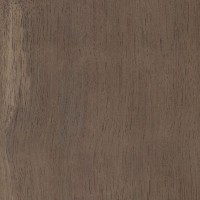 |
Common Name(s): Peruvian Walnut, Tropical Walnut, Nogal Scientific Name: Juglans spp. (Juglans australis, J. neotropica, J. olanchana, etc.) Distribution: Southern Mexico, Central and South America Tree Size: 30-60 ft (9-18 m) tall, 2-3 ft (.6-1.0 m) trunk diameter Average Dried Weight: 37 lbs/ft3 (600 kg/m3) Specific Gravity (Basic, 12% MC): .50, .60 Janka Hardness: 960 lbf (4,250 N) Modulus of Rupture: 11,160 lbf/in2 (77.0 MPa) Elastic Modulus: 1,132,000 lbf/in2 (7.81 GPa) Crushing Strength: 6,550 lbf/in2 (45.2 MPa) Shrinkage: Radial: 3.6%, Tangential: 7.5%, Volumetric: 11.4%, T/R Ratio: 2.1 |
Color/Appearance: Heartwood tends to be darker than temperate walnut species, with a deep chocolate brown color, sometimes with a purplish hue. May also contain streaks of lighter-colored wood mixed throughout the heartwood, which can sometimes be extensive and result in a high degree of waste. Grain figuring such as curl seems to be much less common than other walnut species.
Grain/Texture: Grain is usually straight, but can be irregular. Has a medium to coarse texture and good natural luster.
Endgrain: Diffuse-porous; large to very large pores, few; solitary and radial multiples of 2-3; tyloses commonly present; growth rings distinct; narrow rays not visible without lens, spacing normal; parenchyma banded.
Rot Resistance: Peruvian Walnut is rated as moderately durable in terms of decay resistance, though it is susceptible to insect attack.
Workability: Typically easy to work provided the grain is straight and regular. Planer tearout can sometimes be a problem when surfacing pieces with irregular or figured grain. Glues, stains, and finishes well.
Odor: Peruvian Walnut has a faint, mild odor when being worked that is similar to Black Walnut.
Allergies/Toxicity: Other species in the Juglans genus (such as Black, and English Walnut) have been reported as sensitizers, and Peruvian Walnut is likely to generate similar allergic reactions. Usually most common reactions simply include eye and skin irritation. See the articles Wood Allergies and Toxicity and Wood Dust Safety for more information.
Pricing/Availability: Peruvian Walnut is more expensive than domestic species of Walnut, though it still tends to be moderately priced for an imported lumber. Expect prices to be similar to other mid-range South American imports.
Sustainability: Peruvian Walnut is not listed in the CITES Appendices, but a number of tropical species in the Juglans genus are on the IUCN Red List. The most notable species, Juglans neotropica, is listed as endangered due to a population reduction of over 50% in the past three generations, caused by a decline in its natural range, and exploitation.
Common Uses: Furniture, cabinetry, veneers, flooring, musical instruments, and interior trim.
Comments: Perhaps the most fitting name would be Tropical Walnut, yet the term Peruvian Walnut is commonly used among hardwood dealers, even though the Walnut may not always technically come from Peru. The name Nogal is also used on occasion, and is the Spanish word for Walnut.
Scans/Pictures: A special thanks to Randy Johnson for pointing out the streaks of discoloration that can be found in the wood, and also for contributing a photo of the streaking and a finished product of the wood.


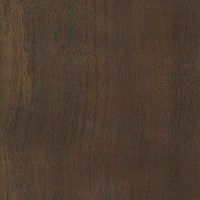
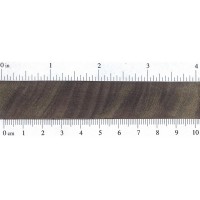
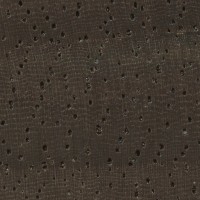
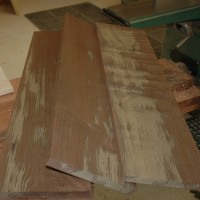
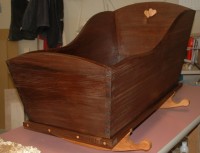
Hi,
I just had a company come redo a room right next to a floor with the same Peruvian Walnut and it is not looking right post seals. Per the lead, he used 2 costs of Bona Natural Seal and then 2 coats of Satin Traffic seal (Bona again). But the wood looks incredibly light and the buffed surface looks cloudy. All the wood looked like the sanded picture at top left above to start.
Thank you,
Julie
Just a thought: could be that they didn’t clean up thoroughly after sanding. Personal experience is that when sanding Peruvian Walnut with grits of 220 or higher, it produces very fine, light colored powder that filters into the grain and produces odd results if not removed via *stong* vacuum or vigorous buffing before finishing.
One of my kilns in Hawaii had trouble drying Koa. Some very valuable pieces came out streaked. John Terry, can you elaborate on your statement that the streaks are caused by wet pockets?
Many years ago, I tested Peruvian in one of my kilns here in PA. I never saw a species collapse so badly.
The streaks were odd. A board with no collapse might look good until it went through the planer. Then streaks were seen.
The light streaks or spots in Peruvian (Tropical) Walnut are moisture pockets.This specie is extremely difficult to dry. I have been able to completely eliminate these streaks by air drying the wood for a prolonged period of time. If my memory is correct we air dried for 18 months more or less. This wood is stable and we generally did not kiln dry it unless the customer demanded kilning. I will also mention that in time these moisture streaks will gradually disappear in a finished product. In a former life I logged and sawmilled in the tropics and we produced… Read more »
How does this wood do in humid climates? Does it crack or warp? We are looking at buying some furniture made of Nogal and it will eventually be shipped to the US.
I have a few pieces of BURL black walnut and I can ONLKY cut with a chainsaw…and thays slo! Had it been petrified…or partialy?
The only thing I can possibly think of is that it is a root burl, and it wasn’t cleaned properly, and there’s rocks or other debris embedded in the wood.
Barring that, wood is wood. I’d almost be willing to bet that a bandsaw would make short work of it.
Thanks…I found that my NEW grizzly 30th aniver. edition had broken locked guide rollers on the bottom, happened immediately. AND U are right…I’ve cut CONCRETE (only kiddin!) with my bandsaw and no problem!
Thanks for your reply…Yer a GOOD guy!
Do love our NOGAL wood also, works tops with most manual/power tools and has an increible feel and color. I did also experience those gray/greenish streaks on several ocassions, but contrary to what Randy mentioned, it only required about 3/4 days of direct light ( day light ) and the issue was totally solved. Nogal, when freshly cut will have a light color and light green streaks are present. Saw mills will normally stack all boards as they are sawed and thus, most boards do not receive light ( with its UV rays…), even those that are oven dried will… Read more »
Absolutely love Nogal –
machines easily, accepts stains and oils well and the moderately
straight grain is a plus over American walnut. The greenish – purple
streaks also add interest and counterpoint
That’s fantastic!
Absolutely love Nogal – machines easily, accepts stains and oils well and the moderately straight grain is a plus over American walnut. The greenish – purple streaks also add interest and counterpoint
I have used this lumber and really enjoy it, but your description does not really address the issue that I have come across, which is the gray-greenish streaking (sometimes filling most of a 4/4 board). This is very costly as you don’t see it unless it is planed. I buy mine rough.
I would gladly send hi-res photos if you would like to use them.
Regards,
Randy